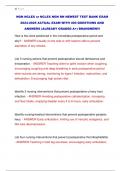1|Page
NGN NCLEX or NCLEX NGN RN NEWEST TEST BANK EXAM
2024-2025 ACTUAL EXAM WITH 400 QUESTIONS AND
ANSWERS (ALREADY GRADED A+) BRANDNEW!!!
How is the client positioned in the immediate postoperative period and
why? - ANSWER-Usually on the side or with head to side to prevent
aspiration of any emesis.
List 3 nursing actions that prevent postoperative wound dehiscence and
evisceration. - ANSWER-Teaching client to splint incision when coughing,
encouraging coughing and deep breathing in early postoperative period
when sutures are strong, monitoring for signs f infection, malnutrition, and
dehydration. Encouraging high protein diet.
Identify 3 nursing interventions that prevent postoperative urinary tract
infection. - ANSWER-Avoiding postoperative catheterization, increasing
oral fluid intake, emptying bladder every 4 to 6 hours, early ambulation.
Identify nursing/medical interventions that prevent postoperative paralytic
ileus. - ANSWER-Early ambulation, limiting use of narcotic analgesics, and
NG tube decompression.
List four nursing interventions that prevent postoperative thrombophlebitits.
- ANSWER-Teaching in bed leg exercises, encouraging early ambulation,
,2|Page
applying antiembolus stockings, teaching avoidance of positions and
pressures that obstruct venous flow.
During the intraoperative period, what activities should the OR nurse
perform to ensure safety during surgery? - ANSWER-Ascertain correct
sponge, needle, and instrument count, position client to avoid injury, apply
ground during electrocautery use, apply strict use of surgical asepsis.
HIV clients with TB - ANSWER-Requires respiratory isolation.
Identify the ways HIV is transmitted - ANSWER-Blood and body fluids.
Unprotected sex, sharing needles, infected blood products, breast milk and
needle sticks.
Vertical transmission from mother to fetus occurs how often if the mother is
not treated during pregnancy? - ANSWER-Vertical transmission occurs
30%-50% of the time.
What are the side effects of amphotericin B - ANSWER-Anorexia, cramping
muscle, and joint pain, and circulatory problems. They can be quite severe.
What does the CD4 T-cell count describe? - ANSWER-Describes the
number of infection-fighting lymphocytes the person has.
,3|Page
Why does the CD4 T-cell count drop in HIV infections? - ANSWER-It drops
because the virus destroys CD-4 T-cells as it invades them and replicates.
Describe the ways a pediatric client might acquire HIV infection. -
ANSWER-Pediatric acquisition may occur through infected blood products,
through sexual abuse and through breast milk.
What modalities are associated with the gate control pain theory? -
ANSWER-Massage, heart and cold, acupuncture, and TENS.
How does past experience with pain influence current pain experience? -
ANSWER-The more pain experienced in childhood, the greater is the
perception of pain in adulthood or with current pain.
What modalities are thought to increase the production of endogenous
opiates? - ANSWER-Acupuncture, administration of placebos, and TENS.
What 6 factors should the nurse include when assessing the pain
experience? - ANSWER-Location, intensity, comfort measures, quality,
chronology, and subjective view of pain.
, 4|Page
If narcotic agonist/antagonist drugs are administered to a client already
taking narcotic drugs, what may be the result? - ANSWER-Initiation of
withdrawal symptoms.
List four side effects of narcotic medications. - ANSWER-Nausea, vomiting,
constipation, CNS depression and respiratory depression.
What is the antidote fro narcotic-induced respiratory depression? -
ANSWER-Narcan. naloxone
What is the first sign of tolerance to pain analgesics? - ANSWER-
Decreased duration of drug effectiveness.
Which route of administration for pain medications has the quickest onset
and the shortest duration? - ANSWER-IV push or bolus.
List the 6 modalities that are considered noninvasive, nonpharmacologic
pain relief measures. - ANSWER-Heat and cold applications, TENS,
massage, distraction, relaxation techniques, and biofeedback techniques.
Identify the 5 stage of grief associated with dying. - ANSWER-Denial,
anger, bargaining, depression, and acceptance.




